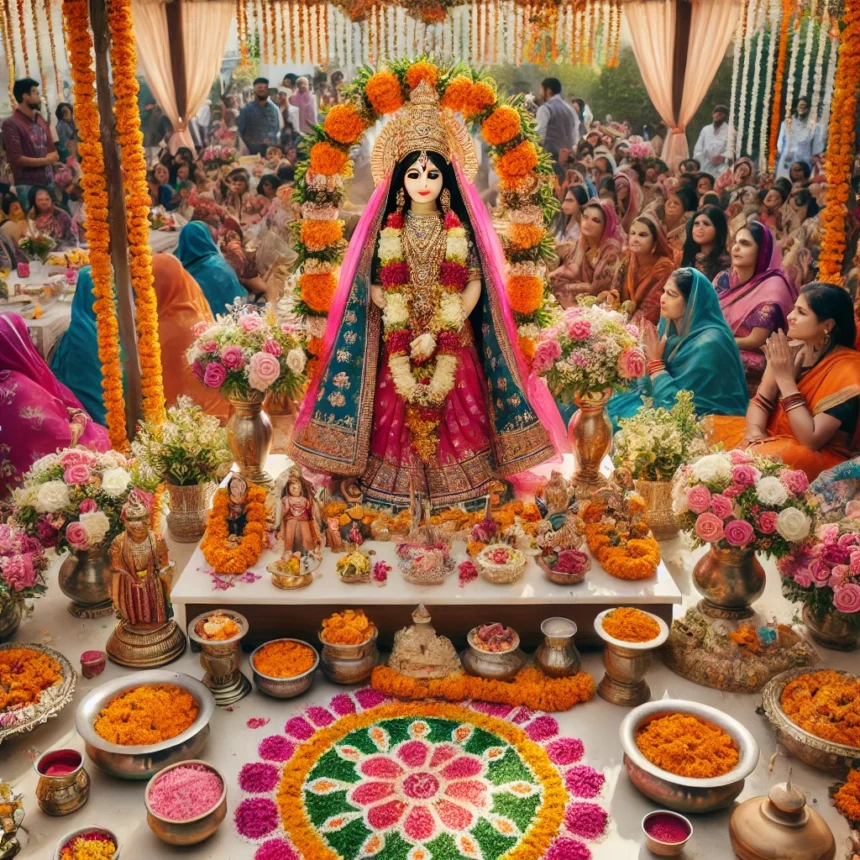Sita Mata: Celebrating Virtue and Devotion on Sita Navami-I
Celebrating Virtues of Sita Mata
Legacy of Sita Mata is at the core of our ongoing series that explores the depth and diversity of Hindu festivals. This installment focuses on Sita Navami, a significant celebration that honors the virtues and fidelity embodied by Sita Mata in Hindu culture. Held annually on the ninth day of the Vaishakha month, this festival brings together devotees from around the world to commemorate the birth of Sita Mata. Through this two part post, we will delve into the historical significance, vibrant rituals, and the modern relevance of Sita Mata’s story. We will cover the story in two parts. Join us in this enriching exploration of first part of the story, where we will cover historical background, elaborate rituals, and cultural impacts of Sita Navami, setting the foundation for a deeper exploration of Sita Mata’s enduring legacy in the subsequent installment.
Historical Background
Goddess Sita, revered as Sita Mata, is a central figure in the ancient Indian epic, the Ramayana, which narrates her life alongside Lord Rama, her consort. According to scriptures, Sita was discovered in a furrow in a plowed field, and was adopted by King Janaka of Mithila, which underscores her divine origins. Her story is pivotal during the swayamvara, where she marries Rama, the prince of Ayodhya, who successfully strings the great bow of Shiva to win her hand.
As a consort of Rama, Sita Mata represents the ideal of fidelity and purity. Her abduction by the demon king Ravana and her subsequent rescue is a significant part of the Ramayana, highlighting her steadfastness and moral virtue. In the narrative, Sita’s unwavering devotion to Rama and her trials, including the agni pariksha (trial by fire) to prove her purity, elevate her as a symbol of dedication and the epitome of righteousness in Hindu texts.
Significance of Sita Navami
As we delve into the story of Sita Mata, it becomes clear that her life and legacy are deeply intertwined with the significance of Sita Navami. This festival, which commemorates her birth, is a celebration of the virtues and values that she embodies.
Sita Navami, known as Janaki Navami, marks the birth of Goddess Sita on the ninth day of the Vaishakha month. This festival celebrates her embodiment of virtue and moral integrity, which are seen as beacons for devotees to emulate. The celebration of Sita Mata’s birth is not just a ritual commemoration; it serves as a symbolic reminder of the qualities Sita epitomizes—courage, purity, and unwavering loyalty.
For devotees, Sita Navami is a day to reflect on Sita Mata’s life and the sacrifices she made, drawing parallels to the challenges faced in one’s own life. Her virtues are particularly resonant today as they symbolize the strength of character and the resilience required to uphold one’s principles in the face of adversity. By venerating Sita Mata on this auspicious day, devotees aspire to cultivate these noble qualities in their lives, promoting spiritual growth and moral excellence.
Celebrations and Rituals
The significance of Sita Navami is not limited to its historical or cultural context; it is also deeply personal and spiritual. The various celebrations and rituals associated with this festival serve as a means of connecting with Sita Mata’s story and cultivating her virtues in our own lives.
Sita Navami, honoring Sita Mata, is marked by a variety of devout rituals and ceremonies across Hindu communities. On this auspicious day, devotees engage in special pujas dedicated to Sita Mata and Lord Rama, invoking their blessings for prosperity and happiness. These pujas often involve the offering of fruits, flowers, and sweets, which are later distributed among family and friends as prasad.
A key aspect of the celebration is the recitation of the Ramayana, especially those chapters that highlight Sita Mata’s life and virtues. This recitation is not merely a religious observance but also a way to impart moral values and teachings of Sita Mata to younger generations. In many households and temples, devotees also observe a fast from sunrise to sunset, symbolizing purification and spiritual renewal.
Temples dedicated to Sita and Rama are beautifully decorated with flowers, lights, and rangoli—a form of traditional floor art using colored powders or flowers. In these sacred spaces, the air is filled with devotional songs and chants, creating a serene atmosphere that resonates with the spiritual significance of Sita Mata’s life.
Celebrations Across the Globe and Significant Locations
As we explore the celebrations and rituals of Sita Navami, it becomes apparent that this festival is not limited to a specific region or community. Rather, it is a global celebration that brings together people from diverse backgrounds and cultures.
Sita Navami is celebrated with much fervor not only in India but also by the Indian diaspora across the world, reflecting the wide-reaching influence of Sita Mata’s legacy. The festival’s observance varies significantly from one region to another, each adding its own local flavor and cultural nuances to the celebrations.
Important Places in India
- Sitamarhi, Bihar: Believed to be the birthplace of Sita Mata, Sitamarhi holds one of the most significant celebrations. The region hosts a large fair, and the Janaki Temple becomes the focal point for religious ceremonies.
- Ayodhya, Uttar Pradesh: As the birthplace of Lord Rama and the setting of many events of the Ramayana, Ayodhya sees elaborate rituals and a series of cultural performances during Sita Navami. The festivities here attract thousands of pilgrims who come to pay homage.
- Rameswaram, Tamil Nadu: Associated with the Ramayana’s epic scenes, including the building of the bridge to Lanka, Rameswaram observes Sita Navami with special pujas and vibrant processions.
- Bhadrachalam, Telangana: Known for its Sree Sita Ramachandra Swamy temple, Bhadrachalam celebrates this day with a grand ceremony known as Sita Rama Kalyanam, reenacting the divine marriage of Sita and Rama.
Celebrations in Nepal
- Janakpur: This city in Nepal is renowned as the kingdom of King Janaka, the father of Sita. Janakpur celebrates Sita Navami with great enthusiasm, featuring elaborate temple rituals at the historic Janaki Temple, which is said to be the birthplace of Sita. The city hosts vivid reenactments of Sita’s wedding to Rama, drawing devotees from both Nepal and India.
Global Celebrations
- United States and Canada: In countries with a significant Indian population, Sita Navami is marked by gatherings in community centers and temples, where expatriates come together to perform pujas and recite the Ramayana. Cultural programs often include classical dance and music performances that tell the story of Sita Mata.
- United Kingdom: Major cities with large Hindu communities like London and Leicester host special events in temples, which include reading of the scriptures and devotional singing. Educational programs for children are also a common feature, teaching them about the life and virtues of Sita Mata.
- Australia and New Zealand: These countries witness gatherings in major cities where the diaspora organizes cultural festivities that often blend local traditions with traditional rituals, illustrating the fusion of cultures.
These celebrations, whether in the heart of India or across the oceans, highlight the universal appeal and timeless relevance of Sita Mata’s story. They serve not only as religious observances but also as cultural bridges that connect the global Indian community with their heritage, showcasing the widespread adoration and respect for Sita Mata.
Reflections on Sita Navami
As we conclude this part of our exploration of the historical and cultural significance of Sita Navami, we find ourselves drawn into the rich tapestry of Sita Mata’s life and legacy. The stories, rituals, and traditions surrounding this festival offer a profound reminder of the importance of virtues such as purity, devotion, and resilience. In our next blog, we will continue to explore the cultural impact, modern relevance, and personal significance of Sita Navami, delving deeper into the ways in which Sita Mata’s story continues to inspire and guide us.
Feature Image: Click here to view the image.
Visit our YouTube Channel by clicking here and Video related to the Blog here.
Click here to visit our Medium channel.
Follow us on our social median handles
Glossary of Terms
- Agni Pariksha: A trial by fire that Sita Mata underwent to prove her purity and fidelity to Lord Rama after being rescued from Ravana.
- Bhagwan: A term in Hinduism used to refer to God or a deity, often translated as “Lord”.
- Janaki Navami: Another name for Sita Navami, celebrating the birth of Goddess Sita, who is also known as Janaki, being the adopted daughter of King Janaka.
- Janakpur: A historical city in Nepal, believed to be the birthplace of Sita Mata and the kingdom of her father, King Janaka.
- King Janaka: The foster father of Sita Mata, who found her in a furrowed field. He was the king of Mithila, known for his wisdom and spirituality.
- Mithila: An ancient kingdom in the Indian subcontinent, regarded as the birthplace of Sita Mata and ruled by King Janaka.
- Puja: A prayer ritual performed by Hindus to offer devotional homage and prayer to one or more deities, to host and honor a guest, or to spiritually celebrate an event.
- Purushottama: A term used to describe an individual of supreme purity and moral excellence, often used to refer to Lord Rama.
- Ramayana: An ancient Indian epic poem that narrates the life of Prince Rama of Ayodhya, his wife Sita Mata, and his loyal brother Lakshmana, including Sita Mata’s abduction by Ravana and subsequent rescue.
- Ravana: The demon king of Lanka who abducted Sita Mata, setting the stage for the epic battle recounted in the Ramayana.
- Rama: The prince of Ayodhya and the hero of the Ramayana, regarded as the seventh avatar of the god Vishnu and a symbol of virtue and righteousness.
- Rama Kalyanam: A ceremonial re-enactment of the divine marriage between Lord Rama and Sita Mata, often celebrated during Sita Navami.
- Rangoli: A form of decoration that uses finely ground white powder and colors, and is used during Hindu festivals to create intricate patterns on the ground.
- Sita Mata: The central female character of the Ramayana, wife of Lord Rama, celebrated for her virtue, purity, and fidelity. Sita Navami is the festival that marks her birth.
- Sita Navami: A Hindu festival that celebrates the birth of Sita Mata on the ninth day of the Vaishakha month in the Hindu calendar.
- Swayamvara: An ancient Indian practice where a maiden (often a princess) chose a husband from among a list of suitors who gathered at her invitation.
- Vaishakha: The second month of the Hindu lunar calendar, during which Sita Navami is celebrated.
- This glossary will help readers better understand and appreciate the cultural and religious contexts mentioned throughout the blog series on Sita Mata and the celebration of Sita Navami.
Top #Tags: #SitaNavami #HinduFestivals #Ramayana #SitaMata #IndianCulture



Leave a Reply